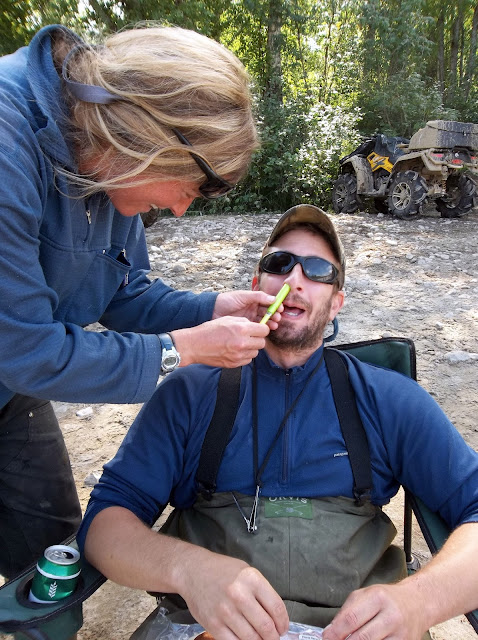Visual opposition to the proposed hydro dam on the Susitna River
Happily we enjoy as much time on the rivers around Talkeetna as we can. We depend on Carlisle to maneuver us up these ever changing rivers with their many braids and fast moving water. The water level is constantly changing depending upon glacial melt. With the sun shining day after day, so unlike AK, the water has stayed quite high. We began the summer with a trip up the Talkeetna to Clear Creek (the name says it all) . Clear Creek offers some wonderful scenery and good salmon and trout fishing.
Life is good
Finding fish is not always easy
We spent some time exploring trapper, Jim Beaver's cabin, now abandoned near the shores of the Talkeetna. It remains as if Jim, or whomever lived there last, left for town and never returned. The roofs are now caved in and I have several slow healing wounds from the half climb, half body drag up the riverbank. Neosporin is amazing! Carlisle is fascinated with the place and now rocks a pair of Jim Beaver's tin pants. I'm sure he would think she does them proud!
We hoped for some trout and one of us, Bill, was successful. If only we had had just a little more time. Despite the 19 hours of daylight, the day seems to fly by. Something about trying to cram too much into 19 hours, particularly when the sun shines.
Where are they headed?
Wow! What are they doing?
Looking back on this day, we were sorry that we didn't go the few additional miles up to Larson Creek, looking for salmon. As it turned out, just a few days later, when we did go there, the salmon were there. It has taken some time for me to understand the cycle of the salmon, in particular the Sockeye, but, in a nutshell, it's nothing short of amazing. The journey, the return to spawn where born, and ultimately death, is all too crazy! Sockeye or Reds as they are commonly called are the type of salmon most available to us in Talkeetna. During July and sometimes into August, these fish return from the ocean by way of Cook Inlet. The fish we eventually catch, have avoided harvest at sea by commercial nets and are homeward bound. From Cook Inlet they travel up the mighty Susitna, some choosing to head up the Talkeetna to Larson Creek. This tiny creek, not more than 6-8 inches deep in places, takes the salmon to Larson Lake where they will spawn. This long and laborious journey is predetermined by their genetic makeup. Each Sockeye will spend some of its juvenile years, 1-3 years in fresh water before migrating to the ocean as smolts. AK Sockeye travel thousands of miles during their time in the Gulf of Alaska, eventually returning to the same fresh water where they were hatched! It's a bit confusing knowing that by catching them, we break the cycle and prevent them from reaching their final destination.
 Lisle and I, standing in Larson Creek where it meets the Talkeetna River, note how silver these fish are.
Lisle and I, standing in Larson Creek where it meets the Talkeetna River, note how silver these fish are.
Stream side medical attention for Pete's nose bleed after being whipped by a willow!
Seriously, I can't look at you!
Helping one another is key. Notice the large fish bonker.
Each fisherperson is allowed 3 Sockeye. When one member of our party finishes, we try to help those remaining to finish quickly so we can enjoy some riverside down time. It is hoped that those who have limited will provide those still fishing with food and drink. However, this did prove to be problematic for Bucky when he held a hot dog in one hand and a fish on the line in his other. Tough decision! No one wants to leave their spot on the river bank. Having someone to resupply tackle is also great. Getting these strong fish safely on shore is not always an easy task. They seem to have an extraordinary will to stay in the water, doing acrobatics which sometimes causes the hook to dislodge before landing.
Picture this size fish in the shallow water of Larson Creek.
No help needed!
limited
Good Eating!
We have frozen fillets, canned 6 cases and are now smoking salmon, all of which takes a lot of time but will taste good this winter and bring back some great memories.
There is a reason that Sockeye are often called Reds. Both males and females die after spawning, but in the process, their bodies take on first a blush and then a definite red appearance. Male Sockeye develop a humped back, large hooked jaw and very sharp teeth. The head of the Sockeye becomes dark green. Really weird!
Poor Lady had a run in with a Russian River fly while we were in Wasilla. She was a pathetic sight when we returned home after having dragged around some line and weight for who knows how long. It took Anja and three others to hold her while the barb was cut and the hook removed. She shook her head and seemed fine.


















